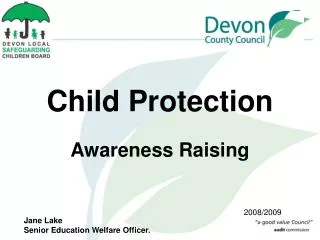CHILD PROTECTION
CHILD PROTECTION. Update for Staff Working in Schools August 2019. Aim of the session. Refresh our knowledge of roles and responsibilities for child protection Refresh our knowledge of indicators of abuse, neglect and risk factors
Share Presentation
Embed Code
Link
Download Presentation

javiern + Follow
Download Presentation
CHILD PROTECTION
An Image/Link below is provided (as is) to download presentation Download Policy: Content on the Website is provided to you AS IS for your information and personal use and may not be sold / licensed / shared on other websites without getting consent from its author. Content is provided to you AS IS for your information and personal use only. Download presentation by click this link. While downloading, if for some reason you are not able to download a presentation, the publisher may have deleted the file from their server. During download, if you can't get a presentation, the file might be deleted by the publisher.
Presentation Transcript
- CHILD PROTECTION Update for Staff Working in Schools August 2019
- Aim of the session • Refresh our knowledge of roles and responsibilities for child protection • Refresh our knowledge of indicators of abuse, neglect and risk factors • Refresh our knowledge of the key processes involved in child protection and new guidance
- Principles Underpinning Session • Be child centred – promoting rights and ensuring child wellbeing is paramount • Get All staff involved • Acknowledge sensitivities and complexities exist around child protection work • Encourage working in partnership, not ‘ silos’ • Be inclusive and anti-discriminatory • Use empowerment – individuals and organisations 'Imperative that training confronts people with their own practice, and with themselves and their values' Tony Morrison 'Emotionally Competent Child Protection Organisations' 1997
- Say Something (NSPCC campaign) • https://www.bing.com/videos/search?q=nspcc++say+something+campaign&view=detail&mid=B43F6B96FE5F7904878DB43F6B96FE5F7904878D&FORM=VIRE
- SAFE Healthy Achieving Nurtured Active Respected Responsible Included NEEDS RISKS
- Child Protection Guidance
- National Guidance 2014 “ Procedures and guidance cannot in themselves protect children; a competent, skilled and confident workforce, together with a vigilant public, can. … Guidance …. enables managers and practitioners to apply their skills collectively and effectively and to develop a shared understanding of their common objective – to promote, support and safeguard the wellbeing of all children, including those who are most vulnerable. ”
- National Guidance – 2014 “All staff who work and/or come into contact with children and their families have a role to play in child protection. That role will range from identifying and sharing concerns about a child or young person to making an active contribution to joint decision making and/or planning and investigation to support the child or young person and their family” Paragraph 322
- What is Child Abuse? “Abuse and neglect are forms of maltreatment of a child. Somebody may abuse or neglect a child by inflicting, or by failing to act to prevent, significant harm to the child. Children may be abused in a family or in an institutional setting, by those known to them or, more rarely, by a stranger.” National Guidance for Child Protection in Scotland 2014 Para. 32
- What is Child Protection? • “child protection” means protecting a child from abuse or neglect. Abuse or neglect need not have taken place; it is sufficient for a risk assessment to have identified a likelihood or risk of significant harm from abuse or neglect. National Guidance for Child Protection in Scotland 2014
- What is Significant Harm? ‘significant harm’ is a complex matter and subject to professional judgement based on a multi-agency assessment of the circumstances of the child and their family. Where there are concerns about harm, abuse or neglect, these must be shared with the relevant agencies so that they can decide together whether the harm is, or is likely to be, significant. National Guidance for Child Protection in Scotland 2014
- Classification of Abuse • Physical injury • Sexual abuse • Emotional abuse • Neglect
- Definition Persistent failure to meet a child's basic physical and/or psychological needs, likely to result in serious impairment of the child's health or development. • Possible Indicators may include: • Always hungry • Inappropriate clothing • Health needs not being met/ not brought to appointments • Poor personal hygiene • Poor self-esteem • Social isolation • Left unattended or with inappropriate adults/poorly supervised • Child late for nursery/school • Carer’s response to child’s behaviour insensitive Neglect
- Children can come to harm through…. • Domestic abuse • Non-engaging families • Parental Mental Health problems, substance use • Harmful traditional practices, such as so called honour-based violence, forced marriage and FGM (female genital mutilation) • Child trafficking • Child sexual exploitation • Online and mobile phone safety • Children/young people who are missing • Radicalisation
- Joint Inspection of Children’s Services and Falkirk’s Case Reviews Key improvement actions: • Neglect- not acting quickly enough • Improve chronologies • Improve risk assessments • Good practice when services make persistent efforts to provide support despite levels of non engagement • Information sharing across agencies and services makes a difference
- Helpful local guidanceUnseen Child Guidance 2016Working with Resistance Guidance 2018Getting Our Priorities Right (children affected by substance use) 2019Escalation 2019
- The role of staff in Education establishments. Becoming aware…. • The child discloses • Observation of injuries • Sustained concern about the presentation or behaviour of the child and/or the parent/carer • Information from another agency/service • Information from another parent, child, friend or community member
- Responding to disclosures/allegations
- Responsibilities of All Staff Health and wellbeing is the responsibility of all staff in schools – not just teachers. • Observe – be alert to indicators of abuse • Record – as heard as soon as possible • Report – suspicion to Child Protection Co-ordinators Thus you will be: • adhering to procedures and guidelines • working within inter-agency guidelines • sharing information appropriately • seeking support and advice • co-operating with other agencies
- Child Protection Co-ordinator contacts Social Work Services • Social Work Services and/or Police Scotland will check records and may decide to investigate • An Initial Referral Discussion (IRD) takes place between Social Work, Police, Health and Education. What Happens Next (1)
- Reporting a concern
- What Happens Next (2) • If concerns or suspicions are founded a child protection case conference may be convened – requiring the most appropriate member of staff to provide a clear report, to attend the conference and to contribute to explaining the child’s views and feelings about their experiences • If the child is at severe risk emergency action may be required ie removal of child to a place of safety. • Child may require ongoing support • Member of staff may require ongoing support
- Concern about a child Interagency Investigation including Police, Social Work, Health, Education Legal Action No further action Child Protection Conference TAC/Continuing Support Child Protection Plan / Registration Criminal Proceedings Children’s Hearing No evidence or grounds Core Groups and Review Child Protection Conference Child Protection Process: An Overview
- The Child Protection Register • A central register of children (including unborn babies) in the area who are the subject of a Child Protection Plan • Has no legal status but alerts practitioners that there is sufficient professional concern about a child to warrant an inter-agency Child Protection Plan. • The decision to put a child’s name on the register will be based on a multi-agency assessment and agreed at the Child Protection Case Conference

Reclaiming child protection
Reclaiming child protection. Liz Davies www.lizdavies.net l.davies@londonmet.ac.uk. Child. Protector. Protector. Abuser. Abuser. Child. Protector. Abuser. Abuser. Abuser. Child. Protector. CHILDISM Oppression of children Child abuse: abuse of power UNCHILDREN
1.22k views • 84 slides

Child Protection
Child Protection. Awareness Raising. 2008/2009. Jane Lake Senior Education Welfare Officer. Looking after Yourself. The subject of this presentation may generate uncomfortable memories and feelings Anything shared during this session will remain confidential. Aims and Objectives.
1.29k views • 32 slides

Child protection
Objectives. Update Think
910 views • 59 slides





